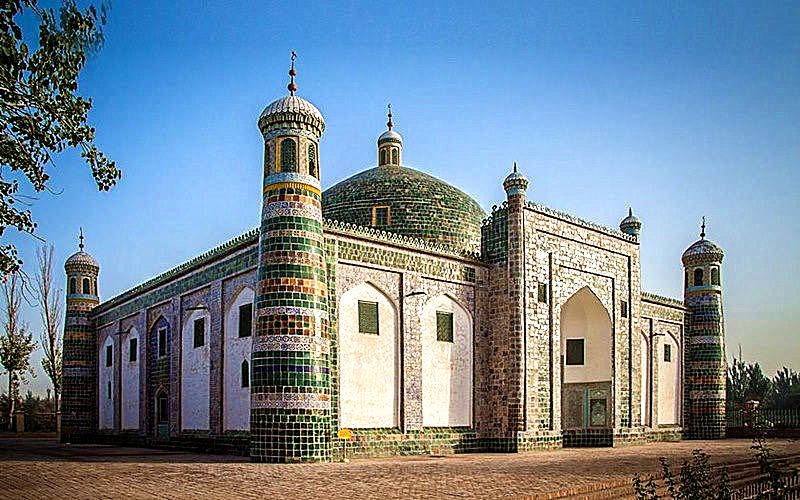Chinese Name: 香妃墓 Pronunciation: xiāng fēi mù
Opening Hours: 09:30-21:30
Ticket: 30 Yuan
Occupied Area: 11.8 Acres
Building Time: 1640
Best Visiting Time: August and September
Recommended Time for Visit: 2-3 Hours
Address: Xiangfei Road, Haohan Township, Kashgar, Xinjiang Uygur Autonomous Region
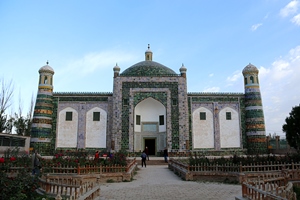
It is said that the concubine of the Qing emperor-"Xiang Fei” (fragrant concubine in Chinese) was buried in the tomb, so the local people also called it "Fragrant Concubine Tomb". The fragrant concubine was the concubine of Emperor Qianlong of the Qing Dynasty. Her real name is MaiMure Aizim. She had a strange fragrance since childhood and was called "Ipaerhan" (meaning "Fragrant girl" in Uyghur).
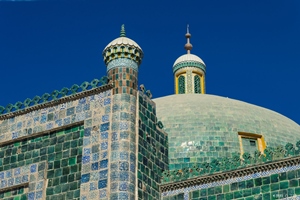
The Abakh Hoja Tomb consists of five parts: a gate tower, a small mosque, a great mosque, a scripture hall, and the main tomb chamber. The main vault is in the eastern part of the cemetery. It is the main building of this complex. It has a magnificent, solemn, and gorgeous style, which is the most magnificent and exquisite tomb in Xinjiang. The main tomb is a cube dome, 36 meters in width, 29 meters in-depth, and 27 meters in height. The walls around the tomb are veneered with green sulfur glazed bricks, inlaid with yellow and blue tiles. The surface of the tiles is painted with colorful patterns and Arabic aphorisms.
The tomb of the fragrant concubine is located at the northeast corner of the platform, and her name is written in Uighur and Chinese in front of the tomb. The tomb mounds are covered with blue glass bricks and various patterns of flower cloth, which not only show respect for the dead but also protect the mound.
The Abakh Hoja Tomb was built in 1640. It is said that 72 people from five generations of the Abakh Hoja family are buried in the tomb (there are only 58 tombs). The first generation was Yusuf Hoja, a famous Islamic missionary. After his death, his eldest son Abakh Hoja inherited his father's missionary career and became a famous master of the Kashgar Islam "Yi Chan Sect" during the period of the late Ming Dynasty and early Qing Dynasty, and once won the power of the Yarkand Dynasty. He died in 1693 and was also buried here. Because his fame surpassed his father, the locals later called the tomb "Abakh Hoja Tomb".
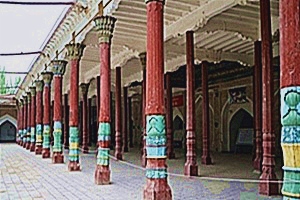
The Small Mosque and the Great Mosque, also called the Luxury Mosque, have seven steps in that the number "seven" is closely related to the religious rituals and customs of Muslims.
The Great Mosque is two or three meters above the ground, sitting north and facing south. The front desk is covered with a ceiling and there is a prayer room behind it. In the middle of the corridor, it adopts the combination of caisson type ceiling painting, wood crimping, and decorative painting. The eaves of the long corridor adopt the unique Uyghur gypsum relief model. The 14 wooden pillars in the corridor are meticulously carved, simple and beautiful.
The Small Mosque is about 2 meters below the ground, sitting west and facing east. It has a dome inside, and this kind of mosque is unique to Xinjiang.
The Small Mosque and the Great Mosque do not look amazing from a distance, but they are small and exquisite, which become the places for daily worship of nearby Muslims. Mostly in the early morning, many devout Muslims can be seen here.
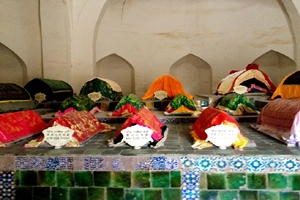
The Main Tomb Chamber is the main body of the Abakh Hoja Tomb, sitting north and facing south, located in the east of the Abakh Hoja Tomb. It is the largest dome-style building and the most magnificent and exquisite mausoleum in Xinjiang. There are huge brick columns half-embedded in the wall on the four corners of the mausoleum. The surrounding walls are all veneered with pale green glazed bricks, with yellow and blue tiles in between mosaic. The surface of the tiles is painted with colored figures and Arabic aphorisms.
The Main Tomb Chamber is open and bright. Right under the platform, which is more than half a meter above the ground, 72 people of five generations of Abakh Hoja and his family are buried. According to Islamic tradition, men are supposed to be buried in the bigger tombs, women in the smaller tombs, and children in the smallest tombs.
In the central part of the Main Tomb Chamber, the tomb hanging a bunch of red flowers is Abakh Hoja’s, the 17th-century leader of Xinjiang Islam "White Mountain". And the tomb of his father, the famous Islamic missionary Yusufu Hoga, is next to his. The fragrant concubine tomb is on the right side of the front row, and the tomb is relatively small and does not occupy a central position.
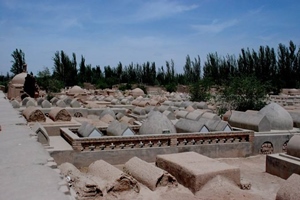
The Main Tomb Chamber is a model of ancient Uyghur Islamic architecture. The bottom of the main tomb is 35 meters long from side to side, 29 meters long from front to back, and 26 meters high. The whole building is built with straw mud and adobe without using a piece of wood. The glazed bricks are glued on the outside with a mixture of plaster, egg white, and fruit juice. Kashgar is an earthquake-prone area, but the Abakh Hoja tomb has been standing steadily for more than 300 years.
At the top of the Main Tomb Chamber, there is a hemispherical arch with a diameter of 17 meters in the center. The large dome in the middle is supported by the four pointed-arches below and the four external arches are supported by three small internal arches, which play a role in decomposing the pressure. This construction method makes full use of the principles of geometry and mechanics.
Xiang Fei (fragrant concubine in Chinese) was born in Yeerqiang (today’s Yarkant County) in Xinjiang in the 12th year(1734 AD) of Yongzheng, Qing dynasty, whose real name is Jamlizimu (also known as Iparhan). She is a descendant of Karmbal, the ancestor of Islam in Xinjiang, and its clan is Hezhuo.
Fragrant concubine’s brother Turdu, uncle and cousin contributed to the suppression of the rebels in the Qing Dynasty and were called by the emperor to be an official. Fragrant concubine followed his brother into the palace. Fragrant concubine did not attract the attention of Emperor Qianlong at first. Until June 19, 1760, a banquet to reward fresh litchis was held in the imperial palace. When Emperor Qianlong passed by, he suddenly smelled a rich and intoxicating fragrance, then stopped and asked the minister: “Where does this fragrance come from?” Turdu, who was standing by the side of the table and not yet seated, heard the emperor’s question, and replied: “Respected emperor, it’s the natural fragrance from my sister Iparhan.” Emperor Qianlong was surprised, so he looked at fragrant concubine, who was standing behind him, wearing a Uyghur costume and having a tall figure. Not only did she look beautiful and mature, but also gentle and charming. The closer you get to her, the stronger the fragrance.
Emperor Qianlong was overjoyed and immediately named the Xiang Fei as a nobleman in the presence of the courtiers and concubines. At night, Emperor Qianlong toasted with the fragrant concubine and fell asleep on the same pillow. From then on, fragrant concubine was favoured by Emperor Qianlong throughout his life. When Emperor Qianlong went to the South for the fourth time, fragrant concubine followed the emperor to tour Suzhou, Hangzhou, West Lake and other places of interest. To February of the thirty-sixth year(1771) of Qianlong, the queen had been dead for several years. Since Emperor Qianlong no longer had a queen, the status of the Fragrant concubine in the palace rose year by year, as if she was a queen.
Since ancient times, many pretty ladies had suffered unlucky destiny. In February 1788 (the 53rd year of Qianlong), fragrant concubine suffered a cold and became ill in the imperial palace. The condition was getting worse and worse. By April, she was dying. Emperor Qianlong was very anxious. The imperial doctors were changed one after another, but no one could cure fragrant concubine. Fragrant concubine knew that she was running out of time, so she arranged her funeral in an orderly manner. She distributed the items accumulated in the palace to her servants and relatives.
On April 19th, when fragrant concubine was on her deathbed, her eyes flashed and her mouth murmured for a while, but she couldn’t speak, as if she had some unfulfilled wish and she didn’t want to leave. The sad-faced Emperor Qianlong had been sitting next to the sickbed of Concubine Xiang. Seeing that fragrant concubine wanted to say something that she could not, he took her hand and said, “Is there any unfulfilled wish, my concubine? Just speak it out, I will try my best to help you to fulfill it.” Hearing the words, fragrant concubine burst into tears, pondering for a long while, and uttered words intermittently with great difficulty: “I wish my soul return to my hometown.” After that, the fragrance disappeared. Emperor Qianlong almost fainted with heartache immediately. At this time, fragrant concubine was 55 years old and had no children in her life. She accompanied Emperor Qianlong in the palace for 28 years.
Emperor Qianlong was very sad for losing his concubine in his old age and ignored the affairs of the state for many days. He intended to fulfill her last wish and sent her body back to Kashgar for burial in accordance with Islamic etiquette. But this is contrary to the rules handed down by the Qing Dynasty’s ancestors. According to regulations, the concubines of the Qing Dynasty can only be buried in the royal concubine garden tomb, and they are never allowed to move back to their original place. In order to not violate the imperial rules, but also to meet the wish of fragrant concubine, an Islamic Muslim during his lifetime, Emperor Qianlong thought over to find a way to get the best of both sides. That is to hire famous woodcarvers and let them use sandalwood to carve according to fragrant concubine’s body shape, appearance, and height. The wood carving looked like a real person, and then the whole body was wrapped with precious silk, leaving only the face for their family members of fragrant concubine to mourn, and the real fragrant concubine’s body was still buried in royal concubine garden tomb.
All of this was carried out in a state of interlocking top secret. Only a few people knew the truth, and no records were allowed in national history. At that time, the concubine’s brother Turdu was also happened to pass away, and Emperor Qianlong ordered to relocate the corpses of the brother and sister to be back to Kashgar. Turdu’s widow was ordered to lead the convoy to escort the coffin back to Kashgar. It took five months to finally reach the destination. Turdu’s widow immediately invited the great Islamic imam to preside over the funeral. Concubine’s relatives uncovered the white veil, inspected the body of fragrant concubine and her brother Turdu, and buried them in a cave after confirming. Today, in the tomb hall in Kashgar, there is still a palanquin that sent the brother and sister back to Kashgar. When people witnessed this historical relic, they really believe that the fragrant concubine was buried here.
If you go to the Abakh Hoja Tomb from Kashgar International Airport, you can take Sightseeing Line 1.
If you go to the Abakh Hoja Tomb from Kashgar railway station, you can walk about 600 meters from the railway station to Kashgar bus station and take bus No.20 and get off at the Abakh Hoja Tomb station.
If you go to the Abakh Hoja Tomb from the center of Kashgar, you can take bus 7 or 23.
By Taxi
Chinese: 请带我去香妃墓。English: Please take me to the Abakh Hoja Tomb.
Chinese: 请带我去阿帕克霍加墓。 qǐng dài wǒ qù ā pà kè huò jiā mù.
If you go to the Abakh Hoja Tomb from Kashgar International Airport, it takes about 22 minutes. (about 30 yuan)
If you go to the Abakh Hoja Tomb from Kashgar Railway Station, it takes about 15 minutes. (about 18 yuan)
If you go to the Abakh Hoja Tomb from the center of Kashgar, it takes about 5 minutes. (about 8 yuan).
